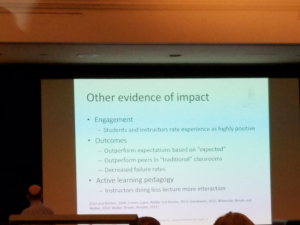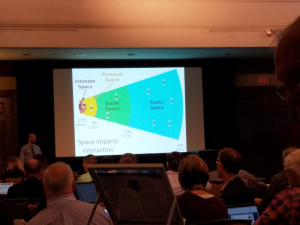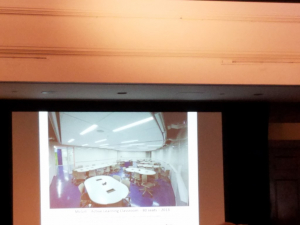 Have you been to a conference with an opening keynote that just didn’t seem relevant to the attendees, their jobs or the trends and topics that they wanted to learn about? Probably. That’s why I like to share when I attend a conference at which the keynote speaker is spot on- knowing his audience, tailoring his content and providing takeaways that make sense and are usable.
Have you been to a conference with an opening keynote that just didn’t seem relevant to the attendees, their jobs or the trends and topics that they wanted to learn about? Probably. That’s why I like to share when I attend a conference at which the keynote speaker is spot on- knowing his audience, tailoring his content and providing takeaways that make sense and are usable.
At the DET/CHE (directors of educational technology/ California higher ed) conference this year, Adam Finkelstein from McGill University took the stage on the first full day of sessions. He had a difficult task; he had to engage and education a room of about 170 attendees with clearly varied jobs. DET/CHE pulls in AV and IT department heads, instructional designers, directors of distance education programs, and even some tech-inspired faculty. They all want to learn about learning technologies, but will understand use the new concepts in diverse ways that fit their position. No matter what their focus was, he grabbed the attendees immediately by proposing that “Higher Ed is under siege. It is neither affordable nor is it a great value.” Yipes! That’s a pretty strong statement, considering just about everyone in the room makes a living at one of these higher ed institutions that, evidently, have little value.
He said that first we have to understand what isn’t true in order to design spaces that provide value, engagement and better outcomes. What is NOT true, according to Finkelstein:
- We only use 10% of our brains
- There are right brain and left brain people
- We remember 10% of what we read, 20% of what we hear, 30% of what we see, etc.
- We should match learning styles to teaching methods (oh, and there aren’t any “learning styles”)
- We are born multi-taskers
- There is an average student
Now Finkelstein transitions to what is true; active learning environments result in decreased failure rates, increased engagement and outperformance of peers in traditional classroom spaces. He doesn’t just say it, he supports it with his own, and others’ research. So if we believe what he says to be true, how do we create environments and develop pedagogy and interact with students to promote active learning? He says that we have to remember, “The one who does the work, does the learning.” Meaning, as students teach and interact with each other they are also learning and retaining the information. Concepts have greater meaning and more depth. Learning has more value.
Our jobs are to create opportunities for active learning. It cannot be forced, and has to occur organically in an environment that encourages interaction. When designing these rooms, we have to keep in mind:
- Space can twist and impact perception
- Space can impact interactions
- Space impacts performance
 Therefore, the space design may have the most impact on the success of an active learning environment. The issue with this, as I see it, is that rooms designed specifically for active learning have inherent hurdles that may prevent the adoption of these spaces as a standard room configuration. First, the technology to make these rooms fully collaborative can be costly. Second, active learning spaces have a higher cost of real estate per student than traditional classroom layouts. In other words, the number of students able to be assigned to the room for a class is greatly reduced. Finally, the time and training it takes for faculty to re-create the curriculum in order to effectively utilize the space is prohibitive. Some faculty take a full semester to re-tool the pedagogy of a single class.
Therefore, the space design may have the most impact on the success of an active learning environment. The issue with this, as I see it, is that rooms designed specifically for active learning have inherent hurdles that may prevent the adoption of these spaces as a standard room configuration. First, the technology to make these rooms fully collaborative can be costly. Second, active learning spaces have a higher cost of real estate per student than traditional classroom layouts. In other words, the number of students able to be assigned to the room for a class is greatly reduced. Finally, the time and training it takes for faculty to re-create the curriculum in order to effectively utilize the space is prohibitive. Some faculty take a full semester to re-tool the pedagogy of a single class.
Are these spaces worth it? Educause has released the learning space rating system that measures the POTENTIAL of a learning space. But how do we measure the ACTUAL results? Finkelstein suggests a combination of interviews, focus groups, surveys and videos. He admits that establishing consistent metrics by which to measure actual active learning space success gets complicated (and subjective) very quickly.


More realistically, the standard classroom will become more of a flex space….which we have discussed in this blog before. It will be a combination of moveable furniture, writable walls and simple to use technology. The ability for the room to be arranged in any configuration from traditional to active learning (and anywhere in between) offers faculty and students flexibility to engage in many ways, at any time. This type of room poses many design challenges including optimal positioning for displays and cameras, storage for equipment, and placement of power and low voltage connections. But it also allows for a greater number of students per class and a combination of traditional and enhanced curriculum.
Adam Finkelstein did a great job getting the audience geared up for the next two days of sessions. But, more importantly, he spoke about challenges that all, no matter what hat they wear, can relate to. And he provided insight that attendees can take back to their campuses and discuss immediately with their teams. For that alone, DET/CHE provided value to their members. Which conferences do you find are a good use of your time or provide content that gets your brain thinking and you blood flowing?
